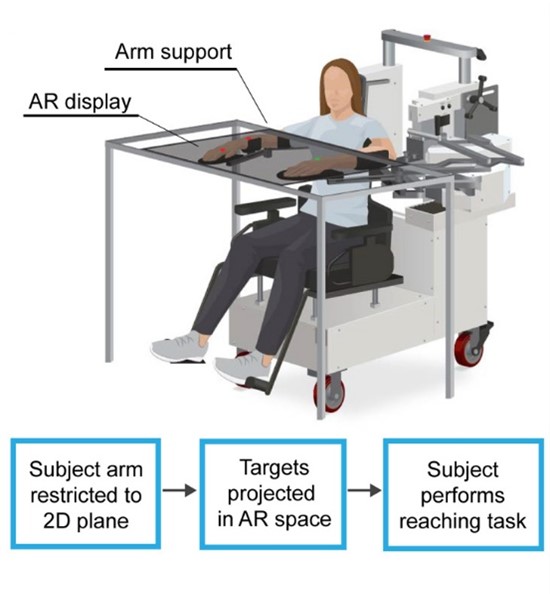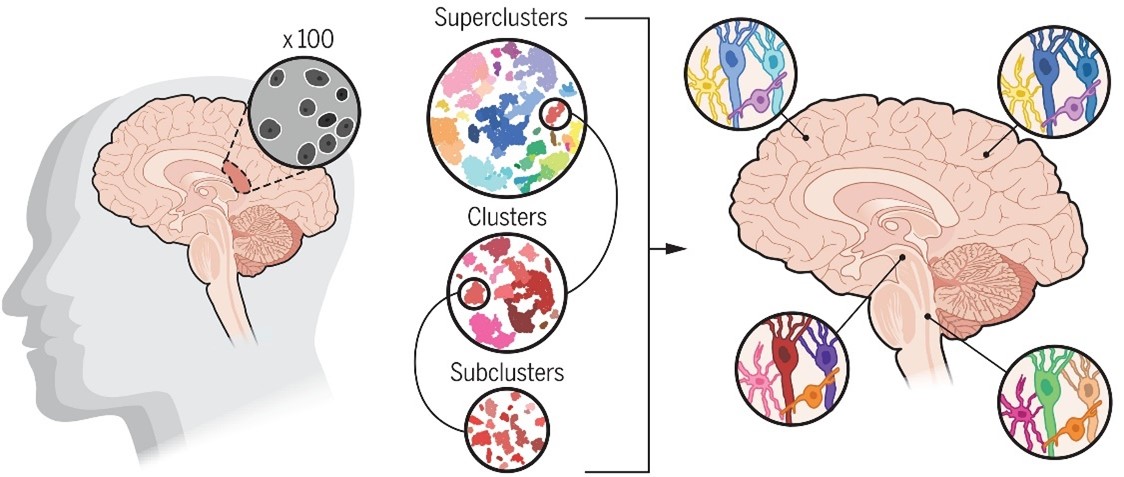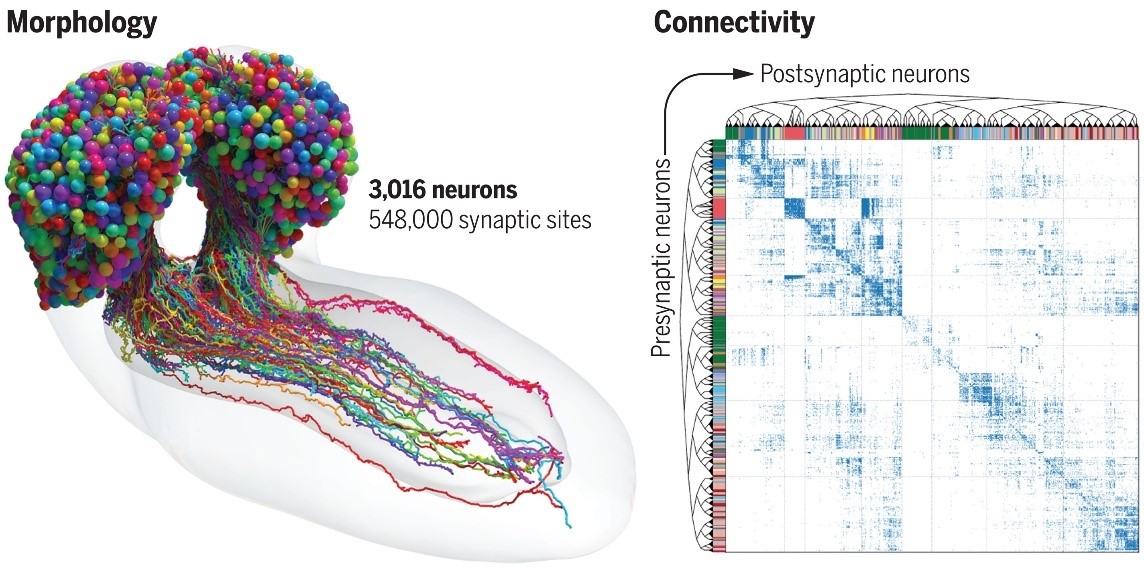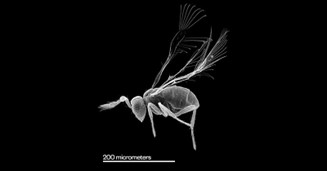Thanks to our incredible researchers and partners, The BRAIN Initiative® had a monumental year in 2023 with many collaborations, events, developments, and accomplishments. Check out the end-of-year recap below to learn more about the latest research and advancements from the BRAIN Initiative, and a first look at what’s to come in 2024.
Advancements in Human Neuroscience
Psychedelic Drugs as Depression Treatment
Treatment-resistant depression is a research focus area for many neuroscientists as part of a concerted effort to find therapies that allow the brain to make new connections and support neural plasticity. New research, supported by the National Institutes of Health’s (NIH) BRAIN Initiative and conducted by University of California scientists, investigates a specific serotonin receptor (5-HT2A), which has been found by previous studies to promote neuroplasticity. The team studied which psychedelic drugs do and do not bind to the 5-HT2A receptor and the intracellular signaling mechanisms involved in promoting neuroplasticity. To learn more, check out the paper on this work published in Science in February 2023.
Spinal Cord Stimulation Helps Restore Arm and Hand Function After Paralysis
Also in February, an NIH BRAIN Initiative study found a new potential therapy for people with arm or hand paralysis using electrical impulses on the spine. The study, published in Nature Medicine, describes how the impulses stimulated the spinal cord’s neural circuits, improving range of motion and strength in both the arm and hand. While the study was small with only two participants, the results are promising and part of an ongoing clinical trial.

An image depicting the experimental set-up to investigate improved range of motion in the arms and hands. Credit: Powell et al., 2023, Nature Medicine.
Brain Biomarkers for Chronic Pain
For the first time, scientists were able to identify biomarkers associated with chronic pain in patients with chronic pain disorders caused by stroke or amputation. A study supported by the NIH BRAIN Initiative, with results published in Nature Neuroscience in May, targeted two brain regions using implanted electrodes and a recording device that participants would press when experiencing pain. Researchers hope the study will be a step forward in understanding brain activity patterns related to pain so that better treatments for chronic pain can be developed.
Promoting Functional Brain Maintenance – Insights from Successful Agers
Over the summer, the Simons Foundation Collaboration on Plasticity and the Aging Brain awarded a collaborative grant to an international team of scientists to expand research on human cognitive aging. This new research effort, titled “Promoting Functional Brain Maintenance – Insights from Successful Agers,” studies elements of brain structure and function that relate to cognition and memory retention in the elderly. The data from the study may help find new ways to promote brain health as we age.
Deep Brain Stimulation for Stroke Recovery
Early results from a clinical trial supported by the NIH BRAIN Initiative revealed that deep brain stimulation (DBS) therapy on the cerebellum may help recover upper limb function after a stroke. Published in Nature Medicine in August, the study sought to determine if DBS was a safe and effective treatment option for people with motor problems caused by stroke. The study was conducted at the Cleveland Clinic, with 9 out of 12 patients demonstrating improved motor function after DBS treatment combined with physical therapy.
Musical Brain Activity
A team of scientists, supported by the NIH BRAIN Initiative, were able to reconstruct a song using brain activity from traced electrode signals. Twenty-nine patients listened to Pink Floyd’s “Another Brick in the Wall, Part 1,” while the research team recorded activity from electrodes placed on the brain’s cortex. The team found 347 significant electrode signals used for music detection and interpretation. Research like this sets the stage for more work that helps us to better understand brain signaling processes and uses music for brain-computer interfacing (BCI). A paper on this work was published in PLOS Biology in August.
Electrical activity in different areas of the brain (yellow and red dots) that were recorded while patients listened to a Pink Floyd song. The song was reconstructed using those brain recordings. Credit: NIH, 2023.
New Deep Brain Stimulation Device Identifies Depression Biomarker
A new device aided researchers in electrophysiology recording to uncover a brain activity pattern related to treatment-resistant depression. Using the tool, the research team delivered DBS to ten clinical trial participants with depression. They were treated using DBS for six months, increasing stimulation levels as the trial went on. The team used AI tools to analyze their data, discovering a biomarker that aligned with depressive episodes. After targeting the biomarker during DBS, nine out of ten patients in the study reported their depression improving. Nature featured a paper on this work in September.
A Deep Look Into the Human Brain
In mid-October, scientists from teams around the world published a suite of more than 20 research papers detailing their creation of a cellular, genetic, and structural map of both the human and nonhuman primate brain. This work was published in Science, Science Advances, and Science Translational Medicine as part of the NIH BRAIN Initiative’s Cell Census Network (BICCN), which aims to understand and create an atlas of brain cell types. After years of studying what sets humans apart from other primates, these scientists examined more than one million cells from more than 100 brain regions. They also identified more than 3,000 distinct brain cell types. The resulting map depicts a level of detail in the brain that was never seen before and will help researchers learn more about brain function to treat neurological disease. This work received global attention, including a New York Times feature and an article in BBC’s Science Focus magazine.

Cellular diversity across the entire human brain. Left: 100 anatomical locations were dissected followed by single-nucleus RNA sequencing. Center: Three levels of clustering to find out cell type composition. Right: Neuron organization and distinct cell types by brain area. Credit: Siletti et al., 2023, Science.
Scientific Advancements in Basic Research
First Complete Insect Brain Wiring Map
In March 2023, researchers from teams around the world published the first completed wiring map of an insect brain (Drosophila, a larval fruit fly) in Science. This is the most complex and detailed brain diagram we have yet. The map identifies 93 distinct neuron types and shows where they connect to form hubs. Research teams traced input and output neuron pathways, finding similar neural circuits to those previously found in machine learning models. Fruit flies share similar genetic foundations and biology with humans, so this work has great promise to guide future research on human brain wiring. It can also guide other comparable research on machine learning and neural circuits. This work was supported in part by the National Science Foundation (NSF), including its BRAIN Initiative NeuroNex program. Check out the NSF’s feature on this work to learn more.

The connectome of the Drosophila larval brain. Credit: Winding et al., 2023, Science.
The Important Role of Astrocytes
Also in March, a study published in Nature Neuroscience described the role of astrocytes in regulating cortical state. Astrocytes are cells that work with nearby neuronal networks in the brain to regulate them. While they are not neuronal cells, astrocytes have been shown to respond to neurotransmitters. In this study, scientists examined how astrocytes interact with the neurotransmitter, norepinephrine, which promotes focus and alertness. The study found that norepinephrine sends alertness signals to neurons while also telling astrocytes to stay calm—a combination that could help regulate attention disorders. This work was supported by the NSF and conducted by researchers at the University of California, San Francisco.
First Map of the Entire Early Visual System in a Single Animal
In September, scientists at the Simons Foundation’s Flatiron Institute created the first ever map of an animal’s early visual system. The scientists mapped the brain of the Megaphragma viggianiiI, a parasitic wasp, using an ion beam scanning electron microscope. Because of the wasp’s small size (much smaller than the commonly studied fruit fly), the team fully mapped everything from the eyes to neurons at the synaptic level. While this wasp’s brain has just a small fraction of the cells that human brains do, its similarities can help us understand basic mechanisms behind behaviors and visual processes. This work was published in Current Biology.

A scanning electron microscopy image of the Megaphragma viggianiiI, a parasitic wasp. Credit: Simons Foundation, 2023.
Measuring Animal Force and Movement Through Phase Shift
The phase shift (ϕ) is a new way scientists are measuring the dominant type of force during animal movement, between inertia, elasticity, viscosity, and gravity. This BRAIN Initiative work is supported in part by NSF through its NeuroNex program and was published in PNAS Nexus in early October. Researchers at NeuroNex use phase shift to measure the timing of each force combined with the timing of limb movement. Phase shift also reveals more about animal biology—different sized animals use different dominant forces even if they are moving the same limb. Understanding these forces means we can treat injured animals better and learn more about how the nervous system responds to movement.
Scientific Initiatives and Programs
Dana Career Network in Neuroscience & Society
In August, the Dana Foundation launched its Dana Career Network in Neuroscience & Society to connect students and early career researchers to career resources. These researchers can learn more about the cross-disciplinary intersection between neuroscience and fields beyond medicine and the natural sciences, including: neurolaw, neuroethics, neuromarketing, neuroeconomics, educational neuroscience, neurodesign, neuropolitics, and much more. The Career Network hosted a virtual career fair and launched a website with resources such as past webinars and presentations, as well as expert interviews and a job board. Be sure to check the website frequently, as it is updated with new postings and tools often.
Neurobiology and Changing Ecosystems Initiative
Also in August, The Kavli Foundation launched the Neurobiology and Changing Ecosystems Initiative to further research related to understanding neural processes that happen in changing environments. The initiative included three inaugural Kavli Exploration Awards granted to researchers to kickstart new exploration into how different organisms’ nervous systems respond to changing environments. The Kavli Foundation has also partnered with The Grass Foundation, providing support to early career scientists interested in studying this field.
An introduction to the Neurobiology and Changing Ecosystems Initiative. Credit: The Kavli Foundation, 2023.
BRAIN Initiative Launches BRAIN CONNECTS Program
The NIH BRAIN Initiative launched a new transformative project in October, the BRAIN Initiative Connectivity Across Scales (BRAIN CONNECTS) program. The program aims to ramp up research efforts to develop new multi-scale brain wiring diagrams. BRAIN CONNECTS supports eleven grants totaling $150 million over five years. Awardees come from dozens of research institutions and universities around the world, promoting scientific collaboration in the realm of brain mapping. Each research project supported by BRAIN CONNECTS will develop a technological approach for imaging and reconstructing brain connectivity.
Total Product Life Cycle Advisory Program (TAP)
Effective October 1, the Food and Drug Administration (FDA)’s Office of Neurological and Physical Medicine Devices (OHT5) joined the Total Product Life Cycle Advisory Program (TAP). This program ensures medical devices are safe, effective, and well-monitored while expanding access to life-saving devices. The OHT5 will lend its expertise in neurological medical devices and develop models for product review and monitoring programs. It will also help develop safety standards, answer questions, and consult with officials on device policies.
EnGINeering Organoid Intelligence (BEGIN OI)
The NSF announced a new funding opportunity in late November through its Emerging Frontiers in Research and Innovation (EFRI) program. EFRI Biocomputing: EnGINeering Organoid Intelligence (BEGIN OI) will help support research that designs and investigates 3D in vitro organoid systems that dynamically process information. NSF hopes that BEGIN OI will lead to transformative ideas and new advances in engineered systems and cognitive science. To learn more about the opportunity and application deadlines, check out the BEGIN OI solicitation.
Catalyzing Across Sectors to Advance the Bioeconomy
The NSF also recently launched the Catalyzing Across Sectors to Advance the Bioeconomy (CASA-Bio) activity in collaboration with other agencies and representatives from industry and non-profits. This initiative will develop a strategy to advance the bioeconomy in the United States. Stakeholders met in December 2023 to discuss approaches and will seek input from the scientific community on relevant research and development opportunities. Check out the CASA-Bio website for more details and for 2024 town hall dates.
Essential Open Source Software for Science
The Kavli Foundation, in partnership with the Chan Zuckerberg Initiative and The Wellcome Trust, launched the Essential Open Source Software for Science program to fund software projects related to neuroscience research. This program is part of The Kavli Foundation’s larger Open Data in Neuroscience program, which supports successful projects such as ClearMap (tools for analyzing and registering cleared tissue), the COmputational Modeling in BIology NEtwork (COMBINE) (tools and methods for multiscale cellular modeling), and Neurodata Without Borders (software that helps build and maintain data standards). Applications for the program were due in December and awardees will be announced in March 2024.
Neurobiology in Changing Ecosystems (NiCE)
At the end of December, the NSF and The Kavli Foundation released a Dear Colleague Letter for a Neurobiology in Changing Ecosystems (NiCE) funding opportunity. The letter outlines the opportunity, proposal guidelines, and submission instructions. All proposals should focus on changing anthropogenic environments, the neural mechanisms that happen because of adapting to changing environments, and how new projects will help organisms or environments survive. There will be multiple awards to advance this area of research during the 2024 fiscal year.
Outreach, Events, and Dissemination
Annual BRAIN Initiative Conference
We were very grateful to hold the 9th Annual BRAIN Initiative Meeting in-person this year! The June 2023 meeting was held in Bethesda, Maryland, and featured a virtual option for those unable to make the trip. More than 800 people attended in-person, with 1,200 participating virtually. The meeting emphasized the importance of scientific collaboration and open science while examining emerging developments in neuroethics and artificial intelligence. The meeting demonstrated the benefit of continued brain science research while investigating ways to drive public engagement. If you missed any sessions, you can catch up with our meeting summary. You can also check out NIH BRAIN Initiative Director Dr. John Ngai’s highlights on The BRAIN Blog.
Annual Show Us Your BRAINs! Photo & Video Contest
The 2023 winners of the Show Us Your BRAINs! Photo & Video Contest were announced at the BRAIN Initiative Conference. Check out our detailed article to learn about each winner, as well as the NIH Director’s Blog posts on the first place photo and first place video winners. Each year, all BRAIN Initiative investigators are encouraged to submit an artistic photo or video from their research to celebrate the beauty of brain research. The top three winners for each category are selected via public vote shortly before the annual conference. The 2023 finalists in the photo category are featured in the 2024 BRAIN Initiative calendar—be sure to download or order a free copy!
The 2023 Show Us Your BRAINs! Photo & Video Contest first place winner in the video category. Credit: Dr. Kari Hoffman and Saman Abbaspoor, Vanderbilt University, and Dr. Tyler Sloan, Quorumetrix Studios, 2023.
Congressional Neuroscience Caucus Briefing
The same week as the Annual BRAIN Initiative Conference in June, several BRAIN Initiative Alliance members hosted a congressional BRAIN briefing that showcased some of the NIH BRAIN Initiative’s impressive neuroscience progress. Dr. Ngai spoke on the BRAIN Initiative’s vision and impacts on improving treatments for brain disorders within our lifetime. Dr. Kafui Dzirasa, a BRAIN-funded investigator and member of the NIH BRAIN Initiative Multi-Council Working Group (MCWG), moderated the event, speaking with Dr. Nicole Provenza, a BRAIN-funded investigator at Baylor College of Medicine in Texas. Dr. Provenza shared the stage with Katie, a patient recovering from obsessive-compulsive disorder through DBS. Jennifer French, founder and executive director of Neurotech Network and member of the BRAIN MCWG, also shared her inspiring story of being paralyzed but able to stand and live a normal life thanks to advanced neurotechnology. Dr. Ed Lein, another BRAIN-funded scientist, demonstrated the importance of funding brain research that helps us better understand Alzheimer’s disease progression. Check out a full summary of the briefing. Following the Congressional Neuroscience Caucus Briefing, leadership from the American Brain Coalition met with members of Congress to discuss BRAIN Initiative funding in fiscal year (FY) 2024.
Dana Discovery Dialogues
In late October, the Dana Foundation launched a new webinar series, the Dana Discovery Dialogues. In this six-month series, hosts Mariette DiChristina and Tyler Jones explore contemporary neuroscience topics to answer questions and dive deep into how the brain works. Previous webinar topics include brain organoids, neurodiversity, and brain-gut connections. Each webinar features experts discussing the latest research and highlighting how it influences everything from our personal decisions to the broader challenges society faces. In 2024, the webinars will cover the neuroscience of decision-making, psychedelics, and brain-computer interfaces.
Simons Foundation’s The Transmitter
In November, the Simons Foundation launched its new publication, The Transmitter, a publication that evolves and expands its highly praised magazine focusing on autism, Spectrum. The Transmitter was developed by the same team that started Spectrum and builds collaborations within the neuroscience community through the latest news and analyses. You can keep up to date with The Transmitter’s latest updates and publications by subscribing to its newsletter.
Society for Neuroscience Annual Meeting
The annual Society for Neuroscience (SfN) meeting in November included satellite events, socials, and special sessions from BRAIN Initiative partners and scientists — for a full list, check out this BRAIN Blog post. A major highlight was the Tools, Tech and Theory: A BRAIN Initiative Alliance Social, where over 450 attendees networked with BRAIN-funded investigators to learn more about their tools. Read more about this event on the BRAIN Blog.
Another highlight was the Institute of Electrical and Electronics Engineers (IEEE)’s two-day workshop on brain discovery and neurotechnology. Keynote speakers and expert panelists discussed three tracks: emerging neurotechnologies, machine learning for brain discovery, and clinical applications and impact. The workshop encouraged collaboration in the neuroscience community and considered emerging topics like neuroethics.
BRAIN Initiative Alliance Toolmakers Newsletters
The BRAIN Initiative Alliance released four newsletters throughout 2023, each featuring four exciting new or developing tools and resources in neuroscience. You can catch up on any newsletters you may have missed here:
Looking Ahead to 2024
Thank you to all BRAIN Initiative investigators, trainees, collaborators, supporters, and enthusiasts for making all of this possible in 2023! We cannot wait to see what we accomplish together in 2024. Below is a preview of upcoming events or opportunities to look out for in the new year. Make sure you download or order your free copy of the 2024 BRAIN Initiative calendar featuring winning images from our Show Us Your BRAINs! Photo & Video contest to keep track of these dates!
- 10th Annual BRAIN Initiative Conference: In 2024, we will celebrate ten years of BRAIN Initiative funded research and the BRAIN Initiative Conference’s 10th anniversary! Mark your calendar for June 16-18, 2024, for this hybrid in-person and virtual event hosted in Bethesda, MD. More details to come.
- FY24 NIH BRAIN Initiative Funding Opportunities: The NIH BRAIN notices of funding opportunities (NOFOs) for fiscal year 2024 were recently highlighted on the NIH BRAIN Blog (Day 1: Transformative projects and tools/tech for cells/circuits; Day 2: Neural recording and modulation; Day 3: Bioethics and systems neuroscience; Day 4: Training, inclusion, and equity; and Day 5: Data science, informatics, and dissemination). Be sure to subscribe to the BRAIN Blog to stay up-to-date on BRAIN funding opportunities and more!
- Neuroethics 2024 – International Neuroethics Society (INS) Annual Meeting: The INS will host its next annual meeting on April 17-19, 2024, in Baltimore, MD. The 2024 theme is “’Expressing Wonder, Making Meaning: Neuroethics Engages the Arts.” There will also be opportunities for virtual participation. Stay tuned for registration information.
- NSF Global Centers Program: The 2024 focus of NSF’s Global Centers Program is “Addressing Societal Challenges through the Bioeconomy.” Global Centers funds research that helps address global challenges, including brain-related topics.
- The Simons Foundation Autism Research Initiative (SFARI): The SFARI plans to release several requests for applications (RFAs) throughout 2024 to support research on autism spectrum disorders. Check out the RFA schedule on the SFARI website.
- BRAIN Initiative FY 2024 Funding: Throughout 2023, the American Brain Coalition circulated numerous letters to Congress requesting enough funding for the BRAIN Initiative to continue its critical research efforts.
Be sure to bookmark the BRAIN Initiative Alliance’s news hub to get the latest updates on 2024’s news, research highlights, funding opportunities, and grantee information. Now onto the next great year of brain research advancement!

